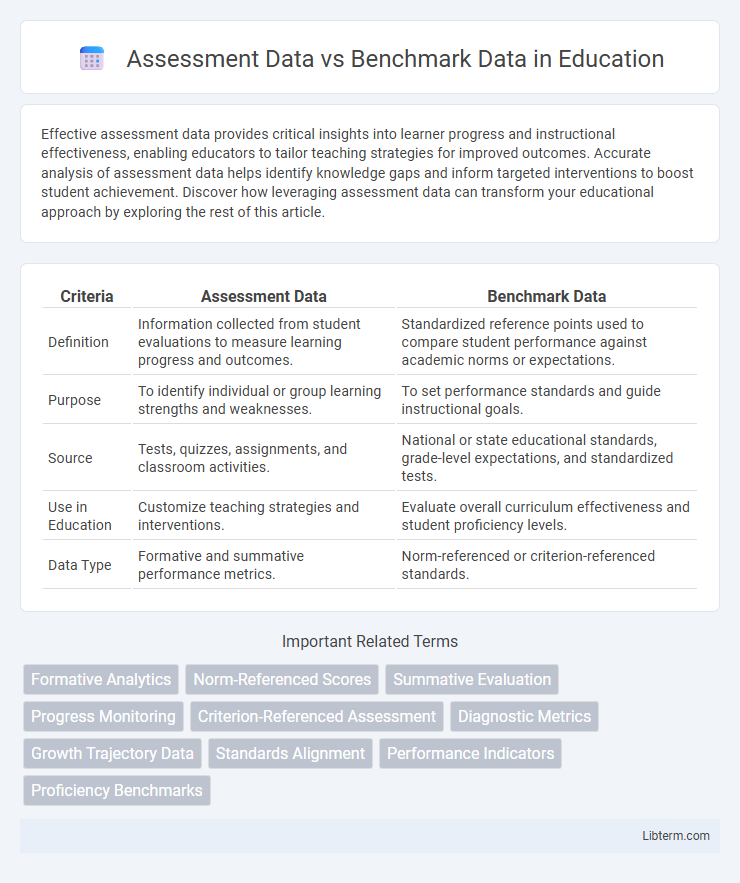Effective assessment data provides critical insights into learner progress and instructional effectiveness, enabling educators to tailor teaching strategies for improved outcomes. Accurate analysis of assessment data helps identify knowledge gaps and inform targeted interventions to boost student achievement. Discover how leveraging assessment data can transform your educational approach by exploring the rest of this article.
Table of Comparison
| Criteria | Assessment Data | Benchmark Data |
|---|---|---|
| Definition | Information collected from student evaluations to measure learning progress and outcomes. | Standardized reference points used to compare student performance against academic norms or expectations. |
| Purpose | To identify individual or group learning strengths and weaknesses. | To set performance standards and guide instructional goals. |
| Source | Tests, quizzes, assignments, and classroom activities. | National or state educational standards, grade-level expectations, and standardized tests. |
| Use in Education | Customize teaching strategies and interventions. | Evaluate overall curriculum effectiveness and student proficiency levels. |
| Data Type | Formative and summative performance metrics. | Norm-referenced or criterion-referenced standards. |
Understanding Assessment Data: Definition and Purpose
Assessment data consists of detailed information collected from tests and evaluations designed to measure student learning, skills, and academic performance within a specific curriculum or instructional period. Its primary purpose is to provide educators with insights into student progress, identify strengths and weaknesses, and inform targeted instructional strategies and interventions. Understanding assessment data enables data-driven decision-making to improve educational outcomes and personalize learning experiences.
What Is Benchmark Data and Why Is It Important?
Benchmark data represents standardized performance metrics collected from a broad sample to establish reference points for evaluating individual or group achievement. It is important because it enables educators and organizations to compare assessment results against established standards, identifying strengths and areas needing improvement. Utilizing benchmark data drives informed decision-making, aligns instructional strategies, and promotes accountability in achieving educational or operational goals.
Key Differences Between Assessment Data and Benchmark Data
Assessment data measures individual student performance through tests designed to evaluate specific learning outcomes, reflecting current achievement levels. Benchmark data provides comparative standards by aggregating performance metrics across groups or institutions, establishing reference points for desired proficiency. Key differences include the scope of measurement--individual versus group--and the purpose, with assessment data guiding personalized instruction and benchmark data informing policy or curriculum adjustments.
Collecting and Analyzing Assessment Data
Collecting and analyzing assessment data involves gathering detailed student performance information through tests, quizzes, and assignments to evaluate individual learning progress. This data is specific, timely, and actionable, allowing educators to tailor instruction based on observed strengths and weaknesses. Unlike benchmark data, which provides comparative metrics across groups or standards, assessment data offers granular insights for immediate instructional adjustments.
How Benchmark Data Guides Educational Improvement
Benchmark data establishes performance standards by comparing student achievement against district, state, or national norms, enabling educators to identify gaps and set realistic goals. This comparative insight directs targeted instructional strategies and resource allocation to address specific weaknesses and accelerate learning growth. By monitoring progress relative to benchmarks, schools can evaluate the effectiveness of interventions and make data-driven decisions for sustained educational improvement.
Comparing Assessment Data and Benchmark Data in Practice
Assessment data measures individual student performance on specific tasks or exams, providing detailed insights into strengths and weaknesses for targeted instruction. Benchmark data aggregates performance metrics across groups at set intervals, enabling educators to evaluate progress toward standards and identify trends over time. Comparing assessment data with benchmark data helps schools align instructional strategies with student needs while tracking overall academic growth effectively.
The Role of Assessment Data in Student Progress Monitoring
Assessment data provides detailed, real-time insights into individual student performance, enabling educators to tailor instruction and interventions effectively. These data points highlight specific strengths and weaknesses, guiding adjustments to teaching strategies that support continuous academic growth. Compared to benchmark data, which offers broad performance standards, assessment data serves as a critical tool for ongoing progress monitoring and personalized learning.
Utilizing Benchmark Data to Set Academic Standards
Utilizing benchmark data enables educators to establish clear, consistent academic standards by comparing student performance against representative reference points such as national or state-wide assessments. This comparison helps identify achievement gaps and informs targeted instructional strategies, ensuring curriculum alignment with expected proficiency levels. Benchmark data provides actionable insights that drive data-driven decision-making and continuous improvement in student outcomes.
Best Practices for Integrating Assessment and Benchmark Data
Integrating assessment data with benchmark data enhances instructional strategies by providing a comprehensive view of student performance relative to established standards. Best practices involve aligning both data types using consistent metrics, regularly updating benchmark targets to reflect curriculum changes, and training educators to interpret combined data for personalized learning plans. Utilizing data dashboards and collaborative data meetings ensures timely interventions and supports data-driven decision-making in educational settings.
Assessment Data vs Benchmark Data: Impacts on Decision-Making
Assessment data provides detailed insights into student performance and learning gaps, enabling educators to tailor instruction and interventions effectively. Benchmark data offers standardized performance comparisons across schools or districts, supporting broad goal-setting and resource allocation. Combining both data types enhances decision-making by balancing individualized student needs with systemic educational targets.
Assessment Data Infographic

 libterm.com
libterm.com